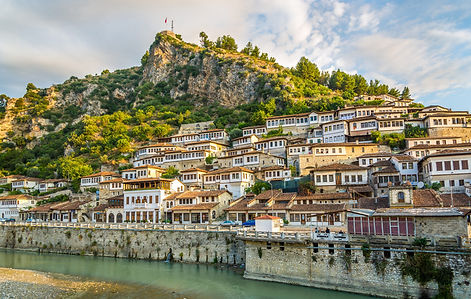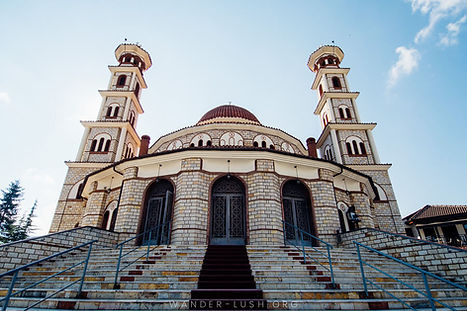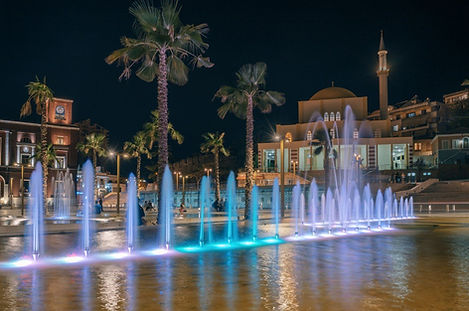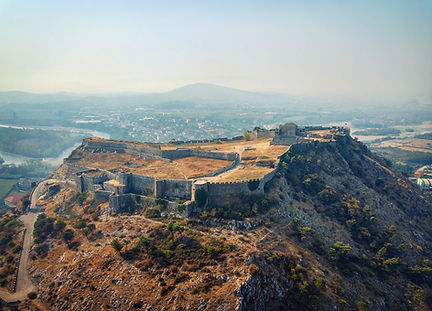
ALBANIA'S BEST CITIES
TIRANA
Tirana, the heart and capital of Albania, like all other European metropolises has never-ending movement and energy. With its clubs, bars, cafes, and taverns, Tirana is worth discovering by both day and night. The hospitality shown towards tourists is something that will mark your journey not only in Tirana but also all over the country.
There are different thoughts regarding the origin of the name of the city. Some think that it relates to Tyrrenia (a name of Etruscan origins), while other believe that it relates to the word Theranda (harvest), or to the Tirkan (a castle at the foot of Mount Dajti).
Your own journey might begin by visiting the museums and the key spots such as Sheshi Skënderbej, where you will be able to see the Mosque of Et’hem Bey (built between 1798 and 1812) and the 35 m high Kulla e Sahatit (the Watch Tower), built in 1822 with a San Marco style cupola. Next, you can visit the famous mosaic uncovered on the floor of an old Roman lodge. Its center configures the walls of the castle of the Roman emperor Justinian (A.D. 520). The monumental Tomb of Kapllan Pasha and the Ura e Tabakëve (a bridge constructed in the beginning of the 19th century, located on Bulevardi Zhan D’Ark) are also worth visiting. As a capital, Tirana has the country’s finest museums, theatres, and galleries representing the
national arts.
A visit to the National History Museum, the Archeological Museum, the Natural Science Museum, the private Mezuraj Museum, and the National Gallery of the Arts will leave wonderful memories. You can also pass a pleasant evening in the National Theatre or the Opera and Ballet Theatre. For dining, Tirana offers both a rich traditional cuisine and a variety of foreign fares, from Italian to Chinese, or even Indian. There are also several clubs and restaurants on Mount Dajti to discover and enjoy. The mountain is reachable by cable car, which provides a fantastic view of the city. In the Tirana region you may also visit the castles of Petrela and Preza, as well as some natural attractions, such as Pëllumbas Cave, Shkalla e Tujanit, and more.
Tirana is unquestionably the dynamic center of Albania thanks in part to its lively nightlife, comprised of theaters, restaurants and clubs. There are a variety of places to entertain you and most of them stay open all night. Bars and clubs can be found throughout town, particularly in the “Blok” area, playing all kinds of live music, including jazz, house, funk, Latin, etc. You can choose to go to the Murphy’s Irish pub or to an American-style bar playing hard rock music. Tirana is home to the Opera House, the National Theater and many other galleries and museums, which in recent years have hosted many artists and world-famous performers. Tirana also offers a wide range of cocktail bars, where you can enjoy some of the best cocktails while listening to music from the best DJs. Downtown, the Regency Casino invites people out to test their gambling luck.
GJIROKASTER
The origin of the city starts with the castle of Gjirokastra, built in IV century AD. The city was named Argyrokastro, in 1336. In 1417, it was conquered by the Ottoman army. The city reached its peak over 1800-1830, when monumental assembly houses were built. The first neighborhoods are those of Bazaar and Hazmurate.
The main characteristic of Gjirokastra is the intensive use of stone in building the houses, which look like small fortresses, the streets of cobblestone, which all lead to Bazaar. You can also visit the Mosque of Bazaar here, built in 1557. Due to all these features, Gjirokastra is also known as the “The Stone City”.
The most important structure of the city is the castle, which is the biggest castle in Albania. Inside the castle, you can visit the Museum of Weapons,opened in 1971. Weapons from the prehistoric times up to the World War II are exhibited on here. The National Folk Festival has taken place in this castle during the years.
During your stay in Gjirokastra, you can visit the Ethnographic Museum, located in the house where the former communist dictator Enver Hoxha was born. This house (today a museum) is located in the Palorto quarter. You can also visit the house of Zekati family in Palorto, in a
dominating position, which has undergone restoration. It is one of the most magnificent and characteristic buildings of Gjirokastra. Built in 1811-1812, it is a magnificent three-floor building and has two twin towers. A special feature of the house is the wooden carved ceilings and the characteristic guest room. From the wooden balcony in the third floor, you can enjoy an impressive view of Gjirokastra.Other important traditional buildings to visit are Angonati House , Babaramonewly restored house , Skendulaj house , Eqrem Cabej House under restoration , Kikino House and many others but also the statue of the main square dedicated to the patriot Cerciz Topulli and other important religious monuments of Bektashi sect and Orthodox religion .
One of the famous spotsto visit at Sokaku i te Marreve that means Mad People Street is also the reconstructed house of the famous Albanian writer Ismail Kadare
The town of Gjirokastra is also known for its culinary art; we can mention special dishes like pasha qofte, shapkat, oshaf with dried figs (a dessert with sheep`s milk, sugar and dried figs), etc.
In Gjirokastra you can visit interesting sites, part of the cultural heritage as well as natural wonders.
BERAT
The city’s life began in the 6th-5th century B.C. as an Illyrian settlement. Later, in the 3rd century B.C., it was turned into a castle city known as Antipatrea. The castle expanded afterwards, particularly during the feudal dominion of the Muzakaj family. Inside the castle, they built churches with valuable frescoes and icons, and also a calligraphy school. Uniquely today, residents still live inside of the castle walls. The three major neighborhoods of the old city are Mangalemi, Gorica, and Kala, where the castle itself is located.
In Mangalemi, below the castle, you can see the famous view of the facades of the houses, with windows that seem to stand above each other. In general, a traditional house has two floors, where the second is prominent and has many cambered windows and wood carvings. With its houses built along the steep hill, the view of Mangalemi is the reason that another name for Berat is the City of the Floating Windows.
Across the Osum River lies the Gorica neighborhood, whose houses face those of Mangalemi. The arched bridge of Gorica, built in 1780, is a beautiful architectural monument constructed to link Gorica with Mangalemi.
The ensemble of the Byzantine churches in the castle of
Berat is extraordinary. At the foot of the castle, there is the Byzantine Church of Shën Mëhilli (Saint Michael), while the 13th century Church of Shën Maria e Vllahernës (Saint Mary Blachernae) , the Church of Shën Triadha (The Holy Trinity), the post-Byzantine monumental Cathedral of Shën Maria (Saint Mary) and many other churches are located in the castle.
The Cathedral of Shën Mëria houses a museum of works by the famous iconographers of the 16th century: Onufri, and his son, Nikolla. There are over 100 icons on display and they also include works of other artists such as Joan Çetiri, Onufër Qiprioti, and many anonymous painters.
You also can visit the Monastery of Shën Spiridhoni (Saint Spyridon) in Gorica. In 1417, the Ottomans occupied Berat and this conquest left its mark with the building of monuments to the Islamic faith, such as the Xhamia e Kuqe (Red Mosque) inside the castle, the Xhamia e Plumbit (1555), the Xhamia e Beqarëve (Celibataires Mosque)(1872) in Mangalem quartier but also Xhamia Mbret (King Mosque) (16th century), and the Halveti Tekke or Tariqa in the medieval center . Other sites worth visiting are the Ethnographic Museum, situated inside an 18th century çardak building, and the Edward Lear Gallery of Art, a well-known English painter who painted much of Berat and Albania. In addition Berat is known for its traditional dishes. It is worth tasting specialties such as pula me përshesh and çorba e Tomorrit in the local restaurants. Is suggested also to visit the Saint Mountain of Tomorr.
KORCA
The city is known for its typical quarters, composed of low houses and villas, which are paved with cobblestone. The city of Korça has a range of museums such as the Education Museum (located in the building where the first Albanian school opened in 1887), the renewed National Museum of Medieval Art (to visit absolutely), the Prehistoric Museum, the House-Museum of the famous landscape painter, Vangjush Mio, the Museum of the Oriental Art “Bratko”, Gjon Mili Photography Museum etc. In the vicinity of the city is the cemetery of French soldiers fallen during the First World War.
The Theatre Cajupi is also a place to see concerts or theatre performances depending by the season .
Apart from the museums and monuments, Korça is the city where the largest carnival in Albania is organized, taking place before Orthodox Easter. Musically, the city is known for the local songs, called serenata. In the city you will find many taverns with tasteful traditional cooking such as various types of pie which perfectly combines with the good music and the traditional drink, raki.
Korça is a very good base for exploring many tourist points located in the nearby mountains such as Voskopoja, Dardha, Vithkuqi and Boboshtica. These villages are well
known for offering the possibility to practice many outdoor sports and activities. The area is also famous for the Byzantine churches of Vithkuqi and Voskpoja, whose walls were painted by famous medieval Albanian painters. Close to Korça you can visit Prespa Lake (which is the country’s largest National Park), Drenova National Park, the Illyrian tummulus of Kamenica, etc.
DURRES
The coastal city of Durrës, located a convenient 34 km from Tirana, is home to Albania’s largest port—and is one of the country’s most ancient cities. “The eternal city” over the Adriatic has a 3,000-year history, its founding dating back to 627 B.C.E. when the Corinthians and settlers from the ancient Greek city of Corcyra, situated in the island of Corfu, invaded the Illyrian territory of the Taulantii people.
Because of its long history, the city is naturally brimming with ancient archaeological sites and findings, including the famous amphitheater of the Roman Emperor Hadrian, whose 15,000-seats capacity make it the second biggest amphitheater in the Balkans.
A litany of surviving objects and buildings attest to Durrës’s history: bathhouses from the 2nd century A.D., a Byzantine forum with marble columns built around the 5th-6th century, and a small 9th century church whose walls are covered with mosaics. These remnants of this past are all a short walking distance from the amphitheater.
The old city was surrounded by a wall, a third of which is still standing. Caesar himself once walked along ancient roads that have survived through history. Those interested in learning more about this history can visit the newly rebuilt Archeological Museum, on Taulantia Road.
Although, “Bukuroshja e Durrësit,” (The Beauty of Durrës), a renowned archaeological mosaic unearthed in Durrës and created during the 4th B.C.E., is held at the National Historic Museum in Tirana.
Durrës is a fantastic destination for history and art buffs: beyond the Archeological Museum, visitors can explore the Ethnographic Museum, which was one home to famous actor Alexander Moissi, and the centrally-located Art Gallery.
Durrës is also perfect for those looking to take a break by the sea, as its sandy beaches and numerous restaurants with a stunning view of the Adriatic, make for a perfect and relaxing day trip.
SHKODRA
Shkodra, it is one of the oldest cities in the country, founded in the 4th century B.C. as the center of the Labeat tribe of Illyrians known with the name Scodra.
Shkodra has been occupied several times throughout history: First by the Romans (168 B.C.), then the Serbians (1040), the Venetians (1396), and finally by the Ottomans (1479).
The city returned to Albanian control as the feudal principality of the Balshaj during the 14th century and served as the municipal center of the Bushatllinj Pashallëk from 1757 to 1831. Shkodra is very rich in cultural heritage , the city itself as well as the people bear pride in the large number of artists, musicians, painters, photographers, poets, and writers born here. Shkodra’s main tourist attraction is Rozafa Castle. Rising majestically upon a rocky hill west of the city, the outcroppings and battlements paint a blazing picture against the setting sun.
It is surrounded by the waters of three rivers; the Drini, Buna, and Kiri. Much like the town it protected, the castle has Illyrian origins. According to the historian Tit Livi, “it was the strongest area of the Labeats.” Like all ancient works, the castle comes with a popular local legend. Rozafa was the name of the bride of the youngest of three brothers who originally built the castle. The three men
worked tirelessly by day laying mortar and stone but the walls always crumbled overnight.
Consulting a wise man, they learned that to expel the evil attacking at their daily work and protect their friends and family with a strong castle that would last through the ages, one of their wives needed to be entombed within the walls. The brothers made a heart-wrenching pact not to alert their wives to this danger, and whoever brought her husband his noon meal the following day would be sacrificed. The elder brothers broke their word however, and it was Rozafa alone who came with food.
When she heard the proclamation, she wept for her newborn son and husband, but allowed herself to become a living part of the walls so that the castle could be built. According to both legend and local folklore, the calcareous water flowing at the entrance of the castle is the milk flowing from one of her breasts, which she requested be left exposed so that she could feed her baby. She also pleaded for one foot and one arm to be left free, in order to rock her son’s cradle at night and sooth him during the day.
Historians tell us a less enchanting and more scientific background of the castle’s characteristics. It reflects the dominion of the Balshaj family but passed through enough other ruling periods that each left their own signs and markings on the grounds, including a distinct Venetian flare, some Ottoman architecture from the 16th and 17th centuries, and even a few modifications from the Bushatllinj family during the 18th and 19th centuries.
Within the castle walls is a museum where a discerning lover of antiquities could spend a comfortable afternoon reading more about its history, and a restaurant has been added to showcase local food and traditional dress.
Shkodra is one of the most important cities of Albania and is also known to be the center of Albanian Catholicism , Culture and Harmony between different religions .
You can visit the renewed Marubi National Museum of Photography famous for its big and rare collection of photos over Albanian history or just take a tour at Pedonalja so called Kole Idromeno street that is the old center of Shkodra , very mediterranean taste passing through mosques and churches.










